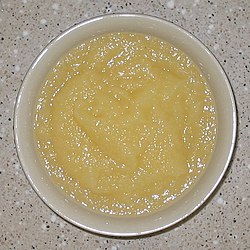
The question of whether applesauce is a liquid often sparks debate, especially when considering its smooth texture and ability to flow. While it may seem like a straightforward answer, the classification of applesauce as a liquid depends on the context in which we’re examining it. This article delves into the characteristics of applesauce, exploring its consistency and comparing its properties to true liquids. We’ll also examine how applesauce is classified in culinary and scientific contexts, ultimately revealing the truth behind this intriguing question.
This exploration will cover the composition of applesauce, analyze its unique texture, and delve into the definitions of “liquid” used in both culinary and scientific realms. We’ll also look at how applesauce is utilized in various applications to further understand its nature.
What is Applesauce?
Applesauce is a smooth, semi-solid food made from cooked and mashed apples. It typically contains pureed apples, often with added sugar, spices like cinnamon or nutmeg, and sometimes lemon juice for tartness. The process of making applesauce involves peeling, coring, and chopping apples before cooking them until soft. These softened apples are then mashed or blended to achieve the desired smooth consistency.
The flavor profile of applesauce can vary depending on the type of apple used, the amount of sugar added, and any additional spices incorporated. Some varieties may have a sweeter taste, while others lean towards a more tart flavor. Applesauce is often enjoyed as a healthy snack, a topping for pancakes or waffles, or as an ingredient in baked goods like pies and muffins.
Consistency of Applesauce
The consistency of applesauce falls somewhere between a true liquid and a solid. It possesses a smooth texture that allows it to flow easily when poured, but its thicker nature prevents it from spreading like water or juice. This semi-solid consistency is primarily attributed to the presence of fruit pulp and fiber within the applesauce.
These particles contribute to the applesauce’s viscosity, making it more resistant to flow compared to a pure liquid. The amount of added sugar can also influence the consistency, with higher sugar content often resulting in a slightly thinner texture. The cooking process itself plays a role as well, with longer cooking times leading to a softer and more spreadable applesauce.
Is Applesauce a Liquid?
The question of whether is applesauce a liquid is not easily answered with a simple yes or no. While it shares some characteristics with liquids, such as its ability to flow, its thicker consistency sets it apart from true liquids like water or juice.
This ambiguity arises because the definition of “liquid” can vary depending on the context. In everyday language, we often use the term “liquid” to describe any substance that flows easily. However, in scientific terms, a liquid is defined as a state of matter characterized by a definite volume but no fixed shape, allowing it to conform to the shape of its container.
Culinary vs. Scientific Classification
In culinary contexts, is applesauce considered a liquid often depends on the specific recipe or application. For instance, in baking, applesauce can act as a liquid ingredient, replacing some of the oil or butter in recipes. However, in other culinary uses, such as serving it as a side dish or topping, its thicker consistency is more apparent.
Scientifically, applesauce would not be classified as a true liquid due to its higher viscosity and presence of suspended particles. It falls under the category of semi-solids or colloids, which are mixtures where one substance is dispersed evenly throughout another. The fruit pulp and fiber in applesauce contribute to this colloidal nature, giving it its unique texture and properties.
Applesauce Uses
Despite its ambiguous classification, applesauce finds numerous applications in both culinary and non-culinary settings. Its versatility stems from its smooth texture, mild flavor, and ability to be incorporated into various dishes.
Culinary Applications:
- Baking: Applesauce can replace some of the fat in baked goods like cakes, muffins, and quick breads, resulting in a moist and flavorful product.
- Sauces and Condiments: Applesauce can be used as a base for savory sauces or as a sweet condiment to accompany pork dishes or roasted vegetables.
Non-Culinary Uses:
- Baby Food: Applesauce is a popular first food for infants due to its smooth texture and easy digestibility.
- Health Benefits: Applesauce contains fiber, vitamins, and antioxidants, making it a nutritious snack option.
Conclusion
The question of whether applesauce is a liquid ultimately depends on the context in which we’re examining it. While its ability to flow might lead us to initially classify it as a liquid, its thicker consistency and presence of suspended particles set it apart from true liquids like water or juice. In culinary contexts, is applesauce considered a liquid often depends on the specific recipe or application. Scientifically, applesauce falls under the category of semi-solids or colloids due to its unique texture and composition. Regardless of its classification, applesauce remains a versatile and popular food enjoyed for its smooth texture, mild flavor, and numerous culinary and non-culinary applications.
